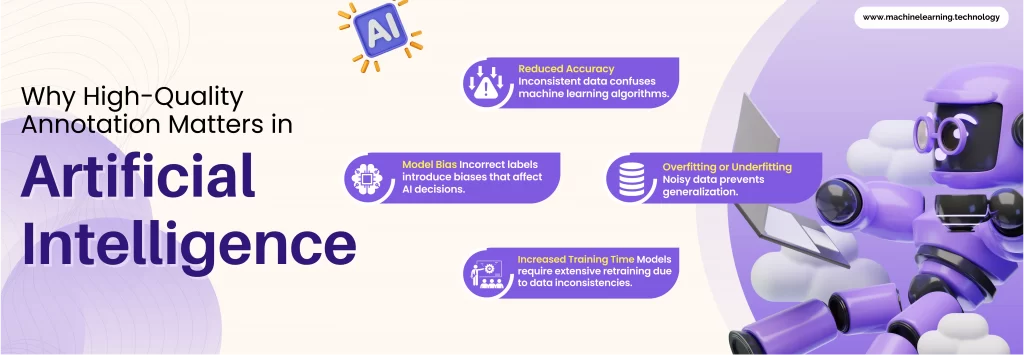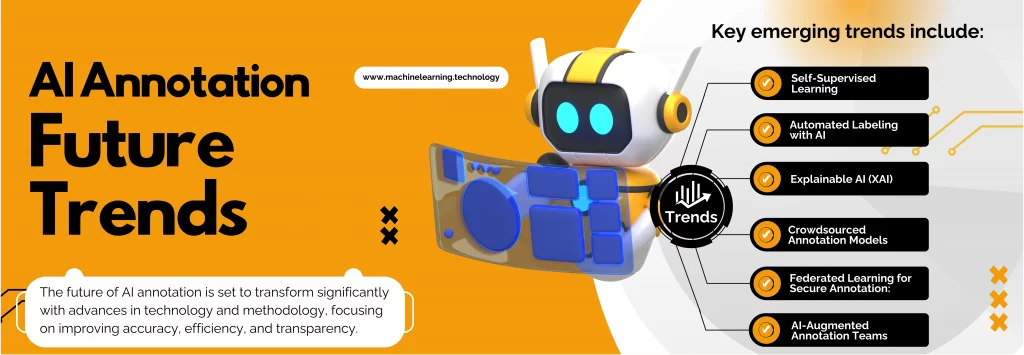The effectiveness of Artificial Intelligence (AI) Models stems from the quality of annotated data available during the training stage. The accuracy and consistency of the annotation directly impact machine learning systems’ efficiency and effectiveness. Data annotation specialists are fundamental to the overall data quality through adequate labeling and validation processes.
This study will define the best techniques for optimizing data labeling, workflow automation, and process control in quality supervision. It will also discuss common issues found in annotation during data collection and point out applicable approaches. This study will explain other approaches from different industries, along with their impact and trends in AI annotation and algorithm evaluation, to demonstrate the relevance of high-quality annotations across various fields.
Why High-Quality Annotation Matters in AI
Annotation is the backbone of AI training. Undone or carelessly labeled data translates to:

- Model Bias: Defective labels affect more components than is imaginable.
- Reduced Accuracy: Lack of coherence bewilders machine learning processes.
- Overfitting or Underfitting: Generalization is impossible with unclear data.
- Increased Training Time: Models take a long time to adjust because data is inconsistent.
Implementing these practices will make AI models more effective and efficient, enabling them to perform optimally in various real-life scenarios.
Best Practices for Annotation Researchers
Set Up Operational Definitions For Labeling
- Prepare well-structured and clear instructions for annotators with many relevant sample(s).
- Identify precisely every label with boundaries, ambiguities, and conflict handlers.
- Create rules (like base outline tagging) less prone to free interpretation.
- Ensure constant refinement of rules from the document based on a round review of the data, feedback from the annotator, and AI performance estimates.
Implement Multi-Tiered Quality Control
- Establish numerous verification processes for annotation, including reviewer validation, automated consistency checks, and routine audits.
- Enable peer reviews of annotations so that they are checked and validated independently.
- Use benchmark datasets (gold standards) when measuring and sustaining annotation accuracy.
- Implement systematic audits to analyze patterns of systematic labeling errors and devise remedial action.
Select Appropriate Annotation Tools
- Choose annotation tools that promote collaboration, allow comments as work is being done, and have controlled versioning.
- Use AI-facilitated annotation tools, such as Labelbox, SuperAnnotate, Amazon SageMaker, or Prodigy.
- Apply active learning strategies to lessen the need for humans to do repetitive, low-level work so they can focus on more advanced decision-making.
- Make sure tools enable sophisticated tracking, analytical, and feedback mechanisms.
Foster High Inter-Annotator Agreement (IAA)
- Analyze and measure consistency across different annotators. Employ some form of sampling, like Cohen’s Kappa, Fleiss’ Kappa, or Krippendorff’s Alpha if necessary.
- Conducted cluster meetings to coordinate the delimiters and the expectations of the annotators.
- Resolve issues of address annotation through focused discussions, consensus-building activities, and a voting process that requires a majority of votes to streamline procedures.
- Continuously improve annotating protocols by recording repeat discrepancies.
Effectively Manage Data Imbalance
- Use data augmentation, oversampling, and undersampling methods to tackle class imbalance ahead of time.
- Social stratification sampling must be employed to ensure the diversity and representation of certain groups within the sample.
- When there is too little authentic data that is unbalanced, use synthetic data generation methods.
- Bolster the effectiveness of AI models through scenario simulation and adversarial training.
Handle Edge Cases and Ambiguous Data
- Record all ambiguous cases and create rules to base decisions for these cases.
- Keep a running annotation notebook of all events and resolutions for complicated cases.
- Revise the annotation instructions frequently in light of experience or feedback from specialists.
- Collaboratively with area specialists to discuss clarifying and resolving complex cases of annotations.
Integrate Active Learning and Human-in-the-Loop (HITL)
- Establish cycles of AI training with the possibility of marking certain highly uncertain/difficult samples for annotation.
- Use semi-supervised methods, blending labeled and unlabeled data into a single process.
- Build automated systems of confidence scoring to efficiently manage the allocation of annotations that need to be reviewed or edited manually.
- Balance manual annotation efforts with AI-assisted predictions to optimize annotation productivity.
Streamline Annotation Workflow
- Enhance annotator productivity through the use of automated pre-annotation processes that also reduce the burden of manual labeling.
- Use batch processing accompanied by organized workflows to optimize and improve the annotation pipelines.
- Clearly define and allocate tasks within user roles to labelers, reviewers, and validators for efficient workflow.
- Conduct regular reviews of each annotator’s performance metrics to discover bottlenecks in the process and identify opportunities for improving workflows.
Prioritize Data Privacy and Compliance
- It should abide by more guidelines like the GDPR or HIPAA and ethical ones regarding AI data use.
- The extreme use of anonymization protects PII, which could be contained in text, images, audio, and video files, from being exposed.
- Unprivileged access and confidential data manipulation are used to maintain the integrity of the data in use.
- Provide solutions that enable the tracking of the origin of data through annotations, ensuring the data is clear and can be traced. This eliminates the possibility of blockchain.
Pursue Continuous Annotation Improvement
- Conduct regular analysis to understand annotation errors and revise the clarity steps of the annotator training and guiding documents correspondingly until desired results are achieved.
- Perform more frequent audits of annotations to evaluate their quality and conduct more retrospective evaluations to maintain and improve quality processes.
- Participate in proactive, collaborative work so that new approaches to annotation or new technology can be incorporated into existing work.
- Develop effective feedback channels for annotators to freely share their ideas and suggestions about the dataset and processes.
How Annotation Researchers Impact AI Model Robustness
Annotation researchers directly contribute to:
- Improving Model Generalization: Annotation researchers ensure that there is adequate diversity and quality of data labels, which allows AI models to learn typical patterns and contextually deal with the learned concepts within various scopes and situations. With the right mix of illustrated edge cases and diverse examples, AI systems become more flexible and robust to unknown data.
- Eliminating Biases Within AI: Using data-improvement strategies that focus on data-collection processes, research authors try to solve biases that result from inadequate data sets, out of which demographic, scenario, and categorization biases represent the most discriminating boundaries of fairness and inclusivity within AI-driven outcomes.
- Increasing Effectiveness Of The Model: Data that is annotated appropriately and of high quality is directly correlated with improving the AI model’s accuracy, speed, and efficiency. Quality control on annotation processes, labeling instructions, and resolving labeling conflicts provides better clues for model training, which results in better model performance.
- Expanding Possibilities of AI: Improving and perfecting how the Annotation Researchers do their work enables them to make the entire labeling process more simple and efficient and increase the number of labels annotated in the same period. The result is faster development of AI systems through the use of streamlined annotation pipelines, which can be applied in various industries such as healthcare, finance, automotive, and retail.
- Enhancing Reliability of the Model: With robust annotation practices, AI models trained on such datasets demonstrate accuracy and reliability even in dynamic, unpredictable environments. This significantly increases the trust and acceptance of AI applications by users, stakeholders, and customers.
Challenges in AI Annotation and How to Overcome Them
| CHALLENGE | SOLUTION |
| High Annotation Costs | Use crowdsourcing platforms, active learning techniques, and semi-supervised learning to reduce manual work. |
| Annotation Subjectivity | Clearly define annotation guidelines, conduct regular annotator training, and implement consensus labeling methods. |
| Scaling Large Datasets | Automate annotations using AI-assisted labeling, leverage existing pre-labeled datasets, and employ distributed annotation systems. |
| Data Security Concerns | Enforce stringent access controls, apply data encryption, anonymize data where possible, and use secure cloud infrastructure. |
| Long Annotation Time | Parallelize workflows, use AI-assisted pre-labeling tools, optimize annotation software for user efficiency, and monitor annotator productivity metrics. |
| Annotator Fatigue and Burnout | Rotate annotators through varied tasks, set manageable workloads, incorporate regular breaks, and maintain motivation through incentives and recognition. |
| Low Quality and Inconsistent Annotations | Implement systematic quality control mechanisms, utilize double-blind annotation, periodically review annotations, and apply performance-based feedback loops. |
| Data Bias and Imbalance | Perform bias assessments, gather diverse annotator groups, apply data augmentation techniques, and deliberately balance class distributions. |
| Complex Task Definitions | Simplify annotation tasks by breaking them down into smaller steps, provide detailed visual examples, and regularly update task documentation based on annotator feedback. |
| Difficulty Recruiting Skilled Annotators | Invest in comprehensive annotator onboarding programs, partner with specialized annotation service providers, and maintain a dedicated annotator network for complex tasks. |
| Ambiguous Data Samples | Allow annotators to flag ambiguous cases, establish escalation paths for expert review, and continually update annotation guidelines based on ambiguity trends. |
| Lack of Annotation Tool Efficiency | Continuously improve annotation tools with feedback from annotators, automate repetitive actions, and optimize software performance and user interface design. |
| Poor Annotator Communication and Coordination | Implement collaborative annotation platforms, schedule regular team meetings, and facilitate clear communication channels between annotators, reviewers, and project managers. |
| Maintaining Annotation Standards Over Time | Regularly retrain annotators, maintain detailed annotation handbooks, and periodically conduct benchmarking exercises and inter-annotator agreement checks. |
Future Trends in AI Annotation

Self-Supervised Learning:
- Leveraging algorithms that learn patterns directly from unlabeled data, significantly reducing dependency on manual labeling.
- Enhancing model scalability and adaptability, allowing rapid deployment in diverse scenarios without extensive annotation overhead.
Automated Labeling with AI:
- Using advanced machine learning models to automatically pre-label datasets, drastically cutting down human annotation workloads.
- Increasing the speed of annotation processes is particularly beneficial in sectors like healthcare, autonomous vehicles, and retail, where rapid data analysis is critical.
Explainable AI (XAI):
- Enhancing transparency of AI decisions by clearly indicating how annotations contribute to final AI decisions is crucial in regulated industries such as finance, healthcare, and law.
- Improving trust and compliance by enabling stakeholders to understand the rationale behind AI-driven annotations.
Crowdsourced Annotation Models:
- Utilizing large, diverse, and geographically distributed annotator pools through digital platforms, enabling cost-effective and scalable annotation.
- Ensuring higher diversity in datasets increases AI model generalizability and reduces biases through collective insights from a varied annotator base.
Federated Learning for Secure Annotation:
- Decentralizing data annotation and AI model training, allowing sensitive data to remain securely on user devices or local servers, preserving privacy and confidentiality.
- Supporting robust data security compliance is especially critical in privacy-sensitive sectors such as healthcare, finance, and government agencies.
AI-Augmented Annotation Teams:
- Integrating human annotators with AI-powered annotation tools to enhance accuracy, consistency, and productivity.
- This allows human expertise to handle complex annotations or edge cases while automating repetitive tasks, maximizing efficiency, and reducing annotator fatigue.
Conclusion
Building robust AI models requires impeccable data annotation. Achieving the necessary level of quality demands comprehensive research, adherence to best practices, automation, and even data ethics compliance. Focusing on precision, consistency, and efficiency may improve AI systems’ performance significantly.
With AI progress, it is clear that annotation researchers will play a crucial role in the evolution of smart, fair, and holistic AI models. Combining AI-assisted annotation with improved workflows and ethical data handling practices sets the stage for the future of AI Annotation, virtually guaranteeing powerful and reliable AI applications across industries.
Want to make your life easier by streamlining your AI annotation workflow? Start following these recommendations now!



